How to build and use UTM parameters in HubSpot?

A quick question: which source is bringing in the most traffic to your website right now?
It’s OK if you don’t know off the top of your head. (We don’t memorize that sort of stuff either!)

Source: Giphy
But wouldn’t it be great if you could pull up the answer in just a few seconds?
What about the conversion rate of different sources?
Or, what about the percentage of traffic generated by social versus email?
You can track it all with utmost ease.
All you need is any Marketing Automation Platform(MAP) - in this case, we are using HubSpot and a little bit of knowledge of UTM parameters.
UTMs are a goldmine for understanding where your traffic originated and how leads interacted with your website.
We will tell you a bit about UTM and then move on to creating and using UTM parameters in HubSpot. If you are already familiar with the term, you can skip to the next part of the article by clicking on any of the following headings:
- What is UTM?
- Creating Custom UTM properties in HubSpot
- Creating Tracking URLs in HubSpot
- Add UTM Parameters as Hidden Fields in all HubSpot Forms
- Update Lead Source using UTMs
- Mapping UTMs using Original Source Drill-down values
- Measure the outcome of ‘Other Campaigns’
- Reporting UTM data in HubSpot
- Let’s Put It All Together
Here’s a quick glimpse of what UTM is all about.
What is UTM?
UTM (Urchin Tracking Module) are text snippets appended to your website URL to track and understand where a website visitor comes from if they click on the link to the website.
To make it easier to bite, see it this way. If you receive a new website visitor, UTM will tell you if that person found your content by clicking on a link through social media, email, or any other marketing channel.
Thus, you are enabled to analyze the performance of your particular campaign by attributing your success/failure to that respective content and medium. And then see if you want to continue with that campaign, drop it altogether, or improvise on the same.
There are five UTM parameters you can add to your website URL. Once this URL is clicked on or visited, the analytics software connected to your website will tell you where the visitor came.
These five UTM parameters are:
- Source - This tells you which platform the visitor came from.
- Medium - This tells you which marketing channel is attracting the users to come to your website. Eg- emails, social media, cost per click, etc.
- Campaign - This tells you which campaign the marketing effort is linked with.
- Term - This tells you about the target keywords associated with your campaign.
- Content - This tells you the specific element or button on your ad/post that was clicked to land on the website.
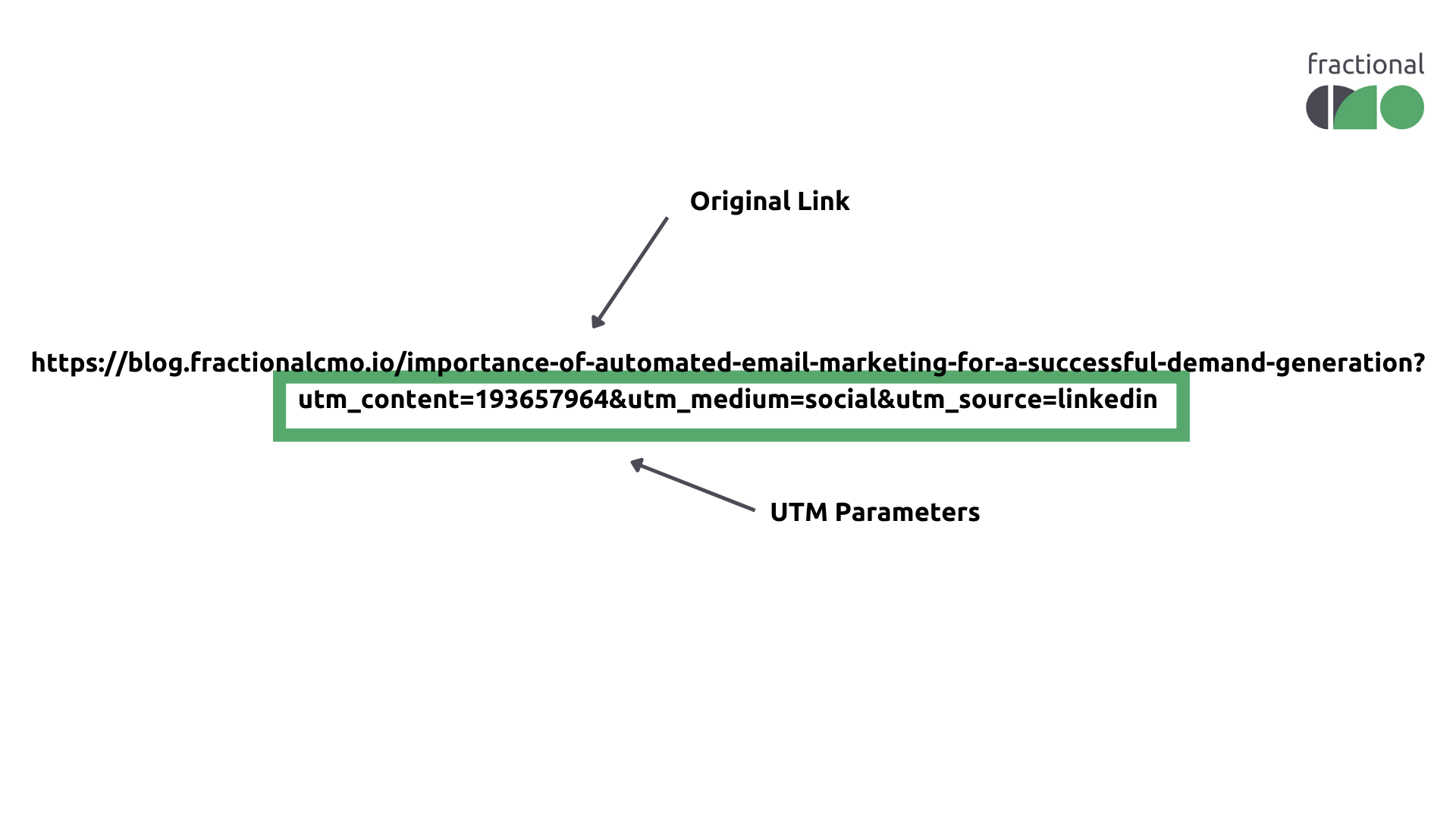 Wondering how this would help?
Wondering how this would help?
This is useful, especially when there are multiple channels to access a piece of content and you want to know which channel performs the best in terms of getting the most visitors.
A reminder on UTMs: Use UTM codes for everything you publish through your channels, like social, emails, and guest posts. Use the same naming parameter across all campaigns so that you can easily compare data.
Let’s take a look at this LinkedIn post. When you click on the link in this post, the below URL will be visible on your browser.
Source: Fractional CMO
You can see,
utm_source= LinkedIn
utm_medium=social
These UTM parameters tell marketers that the social media, specifically LinkedIn post, is attracting traffic to this blog - How to conduct a HubSpot audit - A 10-point checklist and tells you about the amount of traffic this platform is fetching.
HubSpot is a great tool to create UTM parameters for tracking.
How to build UTM parameters in HubSpot.
Creating custom UTM properties in HubSpot
UTM parameters are not collected in any of HubSpot's default properties.
We can create custom UTM parameters as a workaround. You can then use these properties in HubSpot forms, to capture UTM parameters.
Here is how you can create custom properties for UTM parameters:
- In your HubSpot account, click the settings icon and navigate to 'Properties.'
- Click Create Property to create a custom property for each UTM parameter. We suggest that you create a separate group under properties and call it "UTM Tracking".
- In the create a new property sidebar, for the Label, enter the UTM parameter.
- For the Field type, click the dropdown and select Single-line text.
- Confirm that the Show in Forms checkbox is selected.
- Click Create to create the UTM parameters property.
- Repeat the process for all 5 UTM parameters.
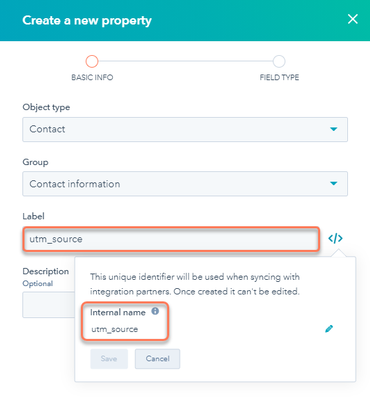
Source: HubSpot
Creating tracking URLs in HubSpot
A tracking URL is a normal URL with UTM parameters attached to it. When visitors come to your site from a tracking URL, HubSpot saves the information in those parameters.
Here is how you can create tracking URLs in HubSpot.
- Locate “Analytics Tools” in HubSpot
On the marketing hub dashboard in HubSpot, locate “Reports”, click on it, and then select “Analytics Tools” from the dropdown menu.
Source: HubSpot
- Click on the “Tracking URL Builder” option
From the menu of “Analytics Tools”, locate “Tracking URL Builder” which you will find in the bottom-left corner, and click on it.
Source: HubSpot
- Locate the tracking URL form to build the UTM code
Any web campaign that you create with at least one UTM code will be listed on the page shown below. This page enlists the UTM tag’s campaign, source, medium, content, term, and date of creation.
Click on “Create tracking URL” in the top right corner.
Source: HubSpot
- Enter all the details of your UTM code and hit “Create”
Click the UTM campaign dropdown menu and select the HubSpot campaign you want visits to this tracking URL to be bucketed under in your analytics tools.
Next, click the Source dropdown menu and select the source for your tracking URL. This will affect where the visit will be categorized in your analytics, including the traffic analytics tool. Some of the source options can be Email marketing, Paid Search, Organic Social, Paid Social, etc.
Other UTM parameters like UTM medium, UTM term, and UTM content are optional.
Source: HubSpot
- Add the tracking URL to the content
Hover over your tracking URL, click the Actions dropdown menu, and select Copy tracking URL. You can also copy the shortened link by clicking Copy short URL and using it for any marketing campaigns. Have a look at the Tweet illustrated below.
Source: SproutSocial
Don't forget: Due to recent changes in AdWords ads, if you're using HubSpot tracking URLs in Google AdWords ads, use the entire link, not the shortened link. Insert the full link into the HubSpot Full Tracking URL into the Final destination field in AdWords ads. The Final destination field must contain the same domain as the landing page URL.
For example, if your ad's landing page is
https://blog.fractionalcmo.io/how-marketing-operations-ignites-lead-generation
The final destination field must contain fractionalcmo.io.
Add UTM parameters as hidden fields in all HubSpot forms
Now that you have the UTM properties and Tracking URLs in place, you need to collect UTM parameters data.
Add them as hidden fields to your HubSpot forms to populate the newly created UTM properties with real-time UTM data. Yes, it is magic! Simply edit the form you're using, add your UTM fields, and set them to hidden.
Note- You must add these hidden fields to every form where you want to enable capturing UTM values
Moving forward, these hidden fields will be automatically populated when a visitor is directed to your form page via a tracking URL appended with UTM parameters. The contact's new UTM property values will be updated when they submit the form. The details of your ads are pushed over in this manner, making your analytics and ad sources very easy to track within your HubSpot portal.
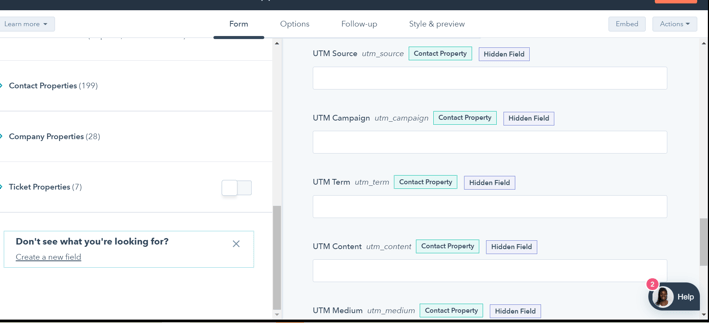
Source: HubSpot
What if you are not using HubSpot forms?
Well, it's simple. Use tools like Zapier to integrate the form with HubSpot, and let the values UTMs parameters pass. (We’ll talk about it in detail in another blog!)
Update lead source using UTMs
While UTM parameters can tell an awesome story about your leads’ interaction with your business, your sales team might want a different outlook on this data.
For example,
They might not want to know whether your leads are coming from Facebook or Instagram. However, they might be interested in total leads coming from paid social.
So, how to present this information to them?
Lead sources are a way to go!
Using HubSpot Workflows, simply map your UTM values to the lead source (a custom field you can create in HubSpot).
Here is how you can map the values:
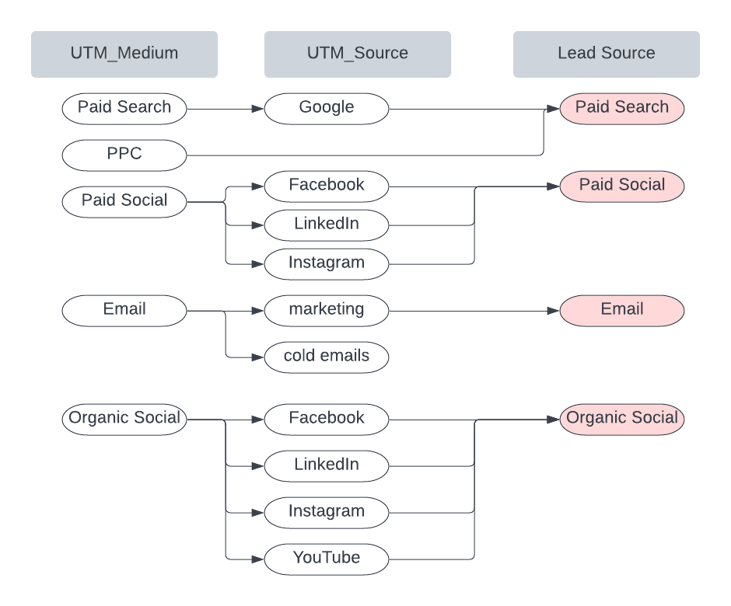
Mapping UTMs using Original Source Drill-down values
We have bad news for you.
You see, tracking UTM parameters has its limitations. For example,
If a Lead/Contact responds to multiple Campaigns, UTM fields are overwritten. This means we might miss the original source of the lead.
To solve this problem (and many other similar problems), we can use Original Source Drill-down values to map the UTM parameters.
For example, if,
Original Source = Paid Social
Original drill-down 1 = Facebook
Original drill-down 2 = facebook_campaign_1
We can set the UTM parameters as,
utm_source=Facebook
utm_medium=social
Utm_campaign = facebook_campaign_1
We can automate this whole process using HubSpot workflows. Here the enrollment trigger can be as follows:
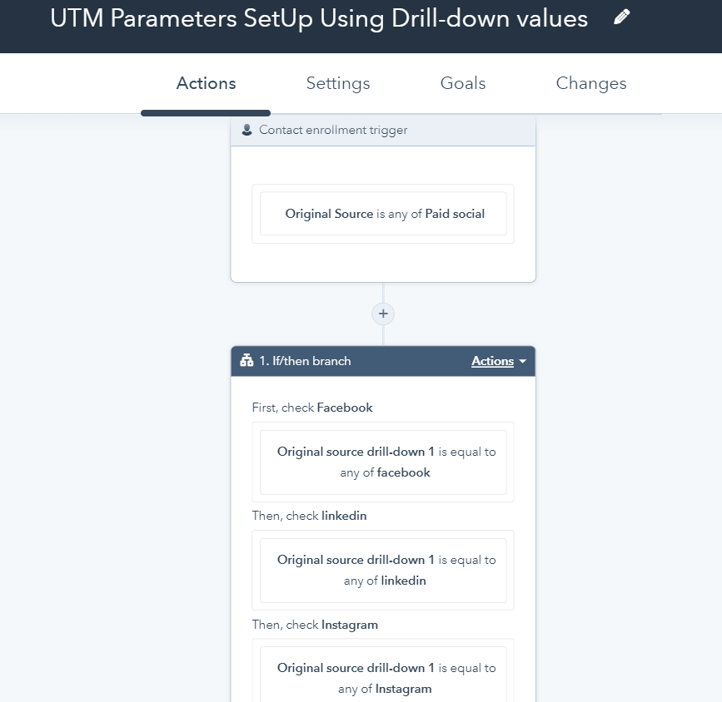
Once, this is done, we can map the utm_source and utm_medium, using the following steps:
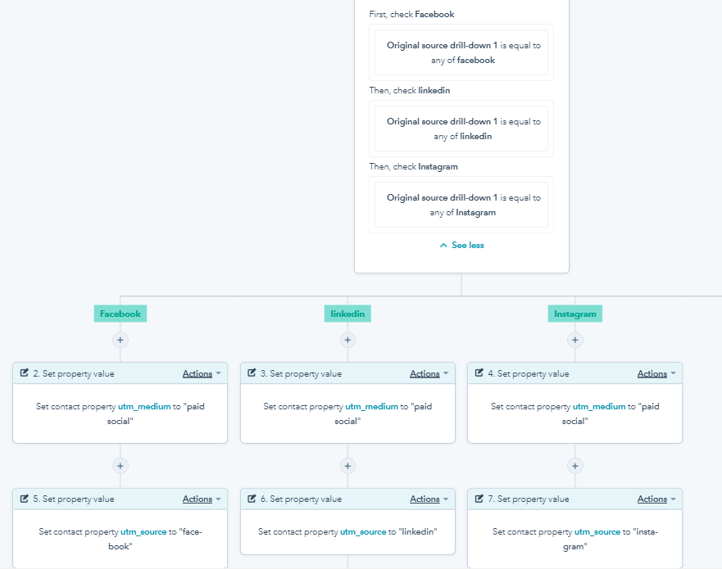
Next, we will map different campaigns for each source using the Original drill-down 2 values:
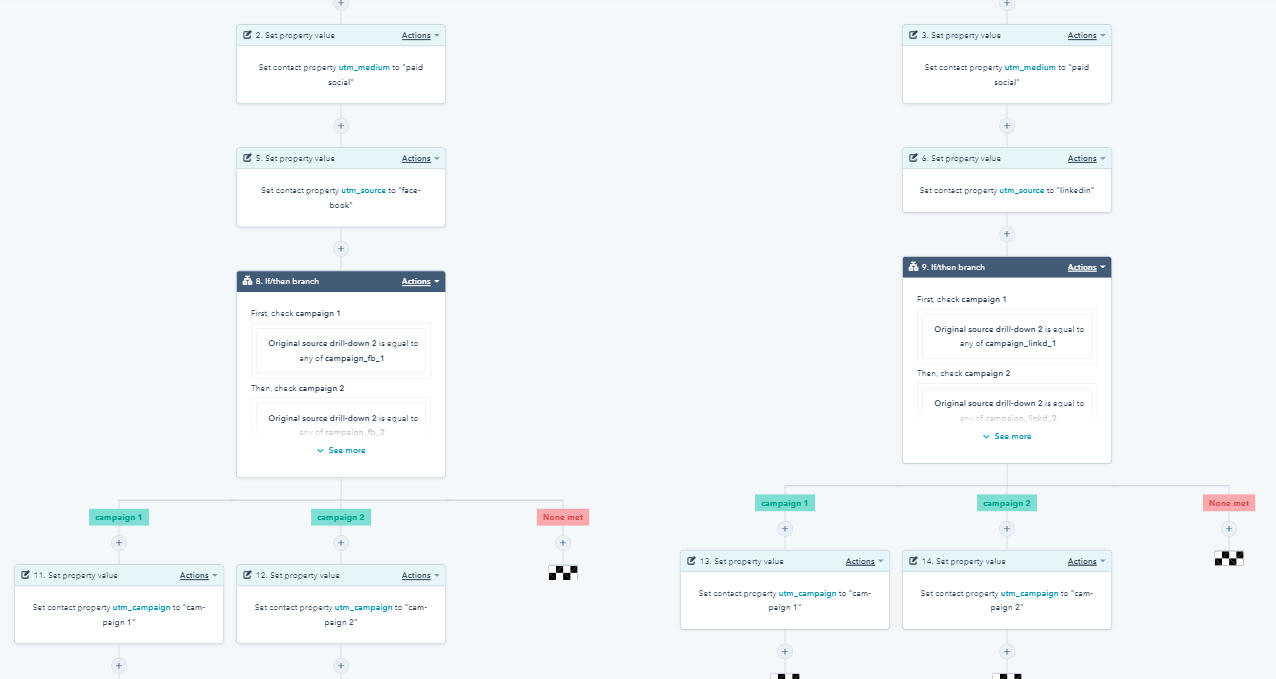
This way, we can map the UTM parameters for different original sources like Organic search, email marketing, paid search, etc.
Need any additional help with these? Feel free to book a meeting with us.
Measure the outcome of ‘Other Campaigns’
In the “Traffic Analytics” dashboard, you have the “Other Campaigns” option. Clicking on it, you will be able to track the UTM parameters. Once you click on a particular campaign, you will be able to fetch the source and medium.
Source: HubSpot
The image below depicts the name of the campaign (according to the text in the UTM code that you created) along with the number of visitors who landed on the main webpage by clicking on this URL.
Source: HubSpot
Reporting UTM data in HubSpot
You can also use custom reports to analyze your UTM data.
Start by creating a new custom contacts report and setting a filter on the report for "utm_source" is known. This isolates your contacts with UTM data values captured at the form submission. On the data tab, add all five UTM properties, and then drop one of them into the report along with the "count of contacts." This will let you quickly group your contacts by UTM values. Using the HubSpot drill-down button, you can further analyze these reports.
Duplicate this report four times if you want to create a similar report for each UTM property. You can also include a date range to further segment and analyze your leads.
Here are some reports you can add to your marketing dashboard:
- Total number of leads generated channel-wise
- Total number of customers generated channel-wise
- Performance of different sources for one ad campaign
There are an infinite number of additional reports that can provide insights into the performance of your marketing content.
Let’s put it all together
With the step-by-step approach above, begin creating the UTM codes and use the UTM parameters in HubSpot to analyze the performance of your content and your campaigns.
But wait, what if you have lots of links on social and outside social? What if your campaign encompasses a large number of blog posts, PPC ads, tweets, and emails?
That’s a lot of links to build one at a time.
We at Fractional CMO can make it easier for you. Get in touch with us today, and we will make sure your UTM tracking strategy is as successful as your business strategy.








